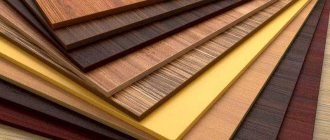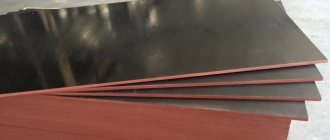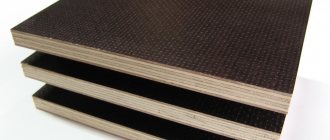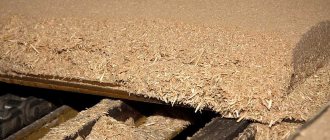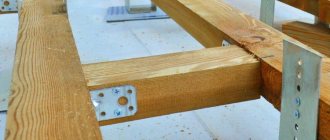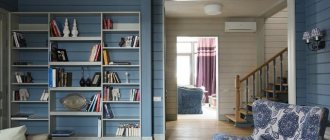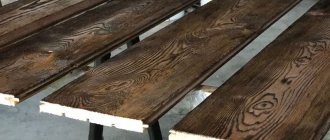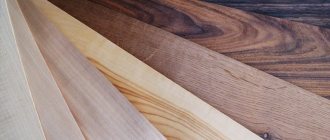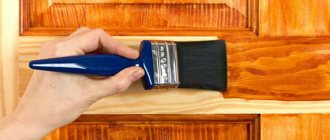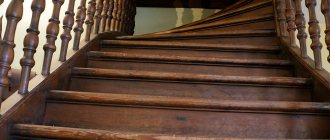Oriented strand board or OSB is a multi-layer building material produced by pressing wood chips. It is most often used for finishing purposes and for lining walls and ceilings. Next, we understand the sizes of OSB boards and the features of working with the material. You will learn how oriented strand boards are painted and classified. Read to the end and you will learn a lot of important and interesting things.
Oriented strand board for ceiling lining Source bmb.by
Classification of OSB boards according to EU standards
Now even Russian manufacturers produce most OSB boards according to the standards of the European Union and the USA. We have the domestic GOST R 56309-2014. It was developed taking into account the European standard EN 300:2006 and has the same markings.
There are OSB boards EN 300 “Oriented Strand Boards of Special Specification”. The grade is distinguished by its resistance to abrasion of the front surfaces, bending strength and increased ability to retain fasteners. Dimensional strength and resistance to moisture allow EN 300 to be used in rather harsh conditions.
An example of using OSB grade EN 300 Source stroyfora.ru
There is another European grade - EN 13986. It is classified as a slab for construction purposes. Its performance is slightly worse than that of EN 300, but the price is also slightly lower.
Within these grades there are four classes of oriented strand boards:
- OSB-1 – boards that are not resistant to getting wet. They are recommended for use in dry rooms or for making furniture.
- OSB-2 is intended for use in dry conditions as a structural board.
- OSB-3 is a structural board for wet conditions. Can also be used for external cladding of buildings.
- OSB-4 is a moisture-resistant building board designed for mechanical loads. It can be used for load-bearing structures.
Regulations
In the Russian Federation, the characteristics of OSB are regulated by GOST 32567-2013 , which you can familiarize yourself with at this link.
The basis of this document was the international standard EN 300:2006 “Oriented Strand Boards (OSB) – Definitions, classification and specifications”. Therefore, slabs that comply with GOST will also comply with the international standard.
The document applies only to the characteristics of the finished product, allowing the manufacturer to independently choose the most suitable technology. We talked about general technological aspects in the article OSB production as a business.
Classification of OSB according to US and Canadian standards
Products from these countries are often supplied to Russia. It can usually be found in large hardware stores. This OSB is quite expensive.
Canadian OSB is often used for exterior cladding of buildings Source fishing-caravan.ru
In North America, there are two grades of oriented strand board: CSA O325, intended for sheathing, and PS 2, or structural wood panels.
These standards coincide in most respects. Therefore, the main role is played by OSB classes:
- W – material for wall cladding
- 1F – OSB for flooring
- 2F – slab for horizontal flooring
- 1R – material for continuous roof sheathing
- 2R – sheets for continuous sheathing with supports at the edges of the roof
Often the same OSB board belongs to several classes at once. For example, 2F16/W24/1R24. The numbers are the maximum distance in inches between supports or posts. Many manufacturers of OSB panels in the USA and Canada additionally mark the location of frame elements on the sheets.
OSB board dimensions
The most common sizes of OSB sheets are 1250x2500 mm according to EU standards and 1220x2440 according to US and Canadian standards. Slabs are available in lengths of 3000 and 3150 mm. On request we can produce OSB sheets up to 7 m in length.
Quite long OSB boards are also produced Source kartinki-kletochki.ru
A wide range of dimensions makes it possible to choose the desired size of the slab. Thus, for interior cladding, large sheets are usually taken in order to ultimately obtain fewer joints.
The thickness of the sheets can range from 6 to 25 mm. The most popular material is various sizes of OSB sheet 9mm thick. In general, this parameter is calculated based on the distance between the supports, the brand of the slab and the expected loads.
Oriented strand boards of various thicknesses Source kras-ki.ru
See also: Catalog of companies that specialize in the design and construction of turnkey country houses.
Introduction
Currently, environmental programs that involve the processing of secondary waste and their further disposal are increasingly valuable. Their result is a reduction in environmental pollution, cheaper raw materials for production, as well as the preservation of natural resources - forests, reservoirs, etc. Many different boards are made from wood waste, in which the main component is wood, and there is also a binding component - resin. The previous article discussed the production of particle boards (chipboards). In this article we will look at another type of board - OSB.
Dimensions of OSB sheets from popular manufacturers
Products from foreign manufacturers are very popular on the Russian market. And although the size range of all of them is approximately similar, there are some differences in dimensions.
Kronospan
This is a reputable Austrian manufacturer of building materials. There are factories of this brand almost throughout Europe, including the Republic of Belarus. The Mogilev plant produces excellent OSB, which is sold in Russia at affordable prices.
A pack of OSB sheets manufactured by Kronospan Source tsarsenal.ru
Kronospan makes oriented strand boards in two classes: OSB-3 and OSB-4. Here is a table with sheet parameters:
| Class | Size, mm | Area, m2 | Weight, kg |
| OSB-3 | 2500×1250×9 | 3.1 | 17.2 |
| 2800×1250×12 | 3.5 | 25.6 | |
| 2500×1250×22 | 3.1 | 41.9 | |
| OSB-4 | 2440×1220×11 | 3 | 20.15 |
| 2500×1250×12 | 3.1 | 23.5 | |
| 2500×1250×15 | 29.4 |
DOK "Kalevala"
This Finnish producer has also proven its seed well on the Russian market. Supplies of building materials of this brand are continuously coming to our country. Therefore, it is useful to know its standard OSB sheet sizes.
| Class | Size, mm | Area, m2 | Weight, kg |
| OSB-3 | 2500×1250×8 | 3,1 | 15,5 |
| 2500×1250×9 | 17,5 | ||
| 2800×1250×12 | 3,5 | 26,1 | |
| OSB-3 with 2-sided tongue and groove | 2500×1250×12 | 3,1 | 23,3 |
| OSB-3 Ecohouse | 2500×1250×9 | 17,5 | |
| OSB-3 Ecohouse with 2-sided tongue and groove | 2500×1250×12 | 26,1 | |
| OSB-3 Ecohouse with 4-sided tongue and groove | 23,3 |
Fire safety OSB
To determine the fire safety of a material, classification according to the degree of flammability is used in accordance with GOST 30244-94.
- Class G-1 (low-flammable). Materials with a degree of damage by area of no more than 65% with a degree of destruction of no more than 20%. The temperature of the flue gases during combustion does not exceed 135 degrees. No melt drops are formed.
- Class G-2 (moderately flammable). A group of materials whose degree of damage during combustion is no more than 85%, the degree of destruction does not exceed 50%, and spontaneous combustion lasts a maximum of 30 seconds. Flue gas temperature is up to 235 degrees. The formation of droplets of melted material is unacceptable.
- Class G-3 (normally flammable). The flammability characteristics are similar to class G-2 - with a difference in spontaneous combustion (300 seconds) and flue gas temperature (450 degrees).
- Class G-4 (highly flammable). Materials of this class have a degree of area damage during combustion of over 85%, the degree of destruction is over 50% percent, and independent combustion lasts more than 300 seconds. The flue gas temperature exceeds 450 degrees.
Types of finishing of OSB boards
Depending on the purpose for which the slab will be used, it is processed differently.
OSB board surface
The plane of the sheet can be sanded or unpolished. The first is necessary for structures where every millimeter of thickness plays an important role. Unsanded sheets are best used under bitumen coatings because they provide increased adhesion. Such slabs are popular in the construction of roof decks and continuous sheathing.
The surface can be varnished. Liquid and paste formulations are used. They are applied using rolling and coating machines. The coating is usually made plain and transparent and quite rarely patterned. Primer or putty is always applied under the varnish layer.
Floor made of varnished OSB tiles Source strojka-gid.ru
Laminated OSB is a material with a layer of paper applied to the surface, impregnated with adhesives. Typically, melamine-containing resins are used as such a composition, which harden when pressed. Laminated boards can be smooth or textured.
Panel composition
OSB sheets are made from shavings of different types of trees. Fragments of certain sizes are glued together with synthetic wax and natural resins. The plate is multilayer, the layers are oriented in different directions, which increases the technical characteristics of the material.
The components for the production of panels are safe and environmentally friendly.
Comparison of OSB and plywood
Both materials are made from wood waste, but there is a difference between them.
| Index | ||
| Shavings of a certain size obtained from one type of wood | Peeled fine veneer from any trees | |
| Binder | Natural resins, wax | Resins, including phenolic and formaldehyde |
| Strength | Depends on the marking | |
| Uniformity | Absent within operating conditions | Possibility of delamination, knotiness |
| 550–700 kg/m 3 | 500–700 kg/m 3 |
What oriented plates exist?
- OSB1. Sheet with low weight, density, thickness. Used in the furniture industry.
- OSB2. A denser sample with an increased number of layers. Used for cladding structures inside dry rooms.
- OSB3. Suitable for rooms with high humidity, periodic (intermittent) exposure. The thickness of the sheet is increased, the strength allows the product to be used under conditions of moderate mechanical stress.
- OSB4. Reinforced panel with a high moisture resistance coefficient. The downside is the price.
Size range
OSB dimensions are not standardized. Suppliers offer cutting to individual measurements; sellers may also offer slabs of different sizes.
The main parameter that determines the types and technical properties is sheet thickness:
2–16 mm. Thin sheets with low strength, low weight. Designed for covering surfaces with small, unstable loads: walls, ceilings, roof bases. Used in the production of furniture fragments.
17–32 mm. The increased thickness provides increased bending strength of the panel; the moisture-resistant effect of the coating allows for cladding of wet rooms. The sheets are used to create SIP panels, finishing surfaces with high loads: walls, floors in industrial premises.
Finished products are sawn according to the dimensional grid, leaving smooth edges on the slabs. For ease of installation, the sections are tongue-and-groove.
The dimensions of the OSB are presented in the table.
Areas of use
Areas of OSB use:
- Internal rough or decorative wall cladding in dry and wet rooms.
- Preparation of ceilings, steps of wooden stairs, floors for finishing coating.
- Production of SIP panels for the construction of frame houses.
- Base for roofing.
- Perimeter fencing of construction sites.
- Laminated panels are used to assemble reusable formwork.
In trade and production areas:
- Creation of shelves and racks.
- Manufacturing of furniture frames.
What and how to paint an OSB board
OSB lends itself well to painting, so it can be used as a finishing coating. The material is coated with the same coloring compounds as wood:
- Acrylic paints are dispersed compositions made from polyacrylates and film formers. Acrylic paints are quite cheap, protect wood from moisture, and are also environmentally friendly.
- Polyurethane paints are compositions that create a protective and decorative film on the surface of wood. They can be used for both interior and exterior decoration.
- Latex paints are non-toxic and flexible. Most often they are used to treat internal surfaces.
- Oil paints are thick compositions that form a thick layer. They are best suited for painting the ends of OSB boards. They dry for a long time and have a specific, persistent odor.
In addition, there are special paints for OSB boards. They have good adhesive properties to the surface of sheets, perfectly penetrate the structure of the material and cover the sheet with a dense layer, preventing the natural color from showing through.
Special compositions for painting OSB boards Source materialexpert.ru
Different sizes of OSB boards are painted with different tools. Small parts, shaped and complex elements are best painted with a spray gun, while large sheets are usually coated with a roller. This gives the thickest possible layer without loss of paint.
Useful tips
For a good purchase, you must analyze the parameters and indicators of OSB boards: sizes and prices, as well as technological parameters. When choosing sheets for laying flooring, you should use the following recommendations:
- it is better to choose materials from Canadian and European manufacturers;
- the flooring is made on a concrete screed or on logs;
- OSB 3 sheets are more suitable for flooring;
- When planning the location of the slabs, it is worth choosing the option that will leave less waste.
Complex finishing using OSB
Useful information! If necessary, the slab is cut with a saw. It is better not to use a jigsaw, as it will not provide a smooth surface.
High-quality OSB boards will help create strong and durable structures. It’s up to you to decide what size slabs and manufacturers to choose.
